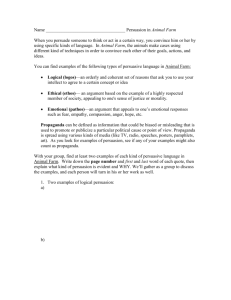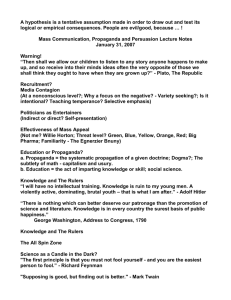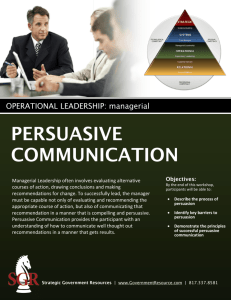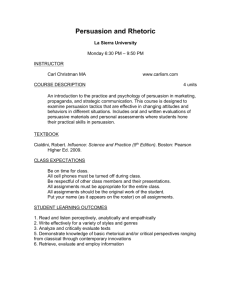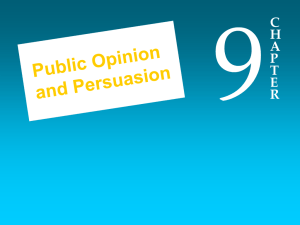Camille Koué Take Home Exam 1 Professor Meltzer
advertisement
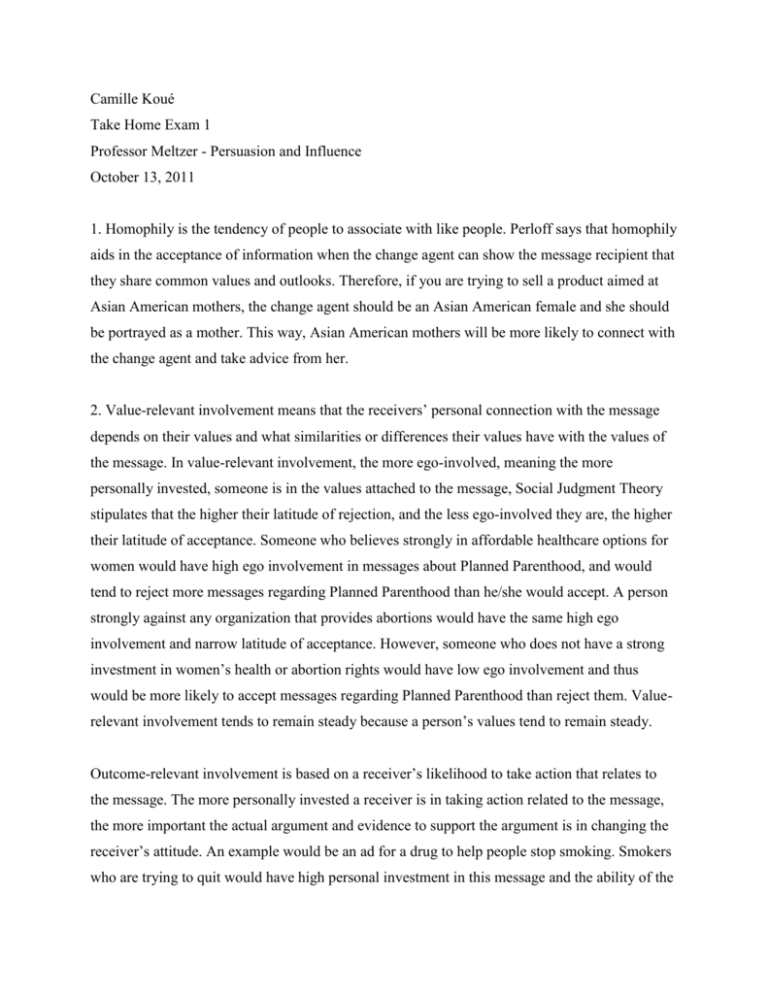
Camille Koué Take Home Exam 1 Professor Meltzer - Persuasion and Influence October 13, 2011 1. Homophily is the tendency of people to associate with like people. Perloff says that homophily aids in the acceptance of information when the change agent can show the message recipient that they share common values and outlooks. Therefore, if you are trying to sell a product aimed at Asian American mothers, the change agent should be an Asian American female and she should be portrayed as a mother. This way, Asian American mothers will be more likely to connect with the change agent and take advice from her. 2. Value-relevant involvement means that the receivers’ personal connection with the message depends on their values and what similarities or differences their values have with the values of the message. In value-relevant involvement, the more ego-involved, meaning the more personally invested, someone is in the values attached to the message, Social Judgment Theory stipulates that the higher their latitude of rejection, and the less ego-involved they are, the higher their latitude of acceptance. Someone who believes strongly in affordable healthcare options for women would have high ego involvement in messages about Planned Parenthood, and would tend to reject more messages regarding Planned Parenthood than he/she would accept. A person strongly against any organization that provides abortions would have the same high ego involvement and narrow latitude of acceptance. However, someone who does not have a strong investment in women’s health or abortion rights would have low ego involvement and thus would be more likely to accept messages regarding Planned Parenthood than reject them. Valuerelevant involvement tends to remain steady because a person’s values tend to remain steady. Outcome-relevant involvement is based on a receiver’s likelihood to take action that relates to the message. The more personally invested a receiver is in taking action related to the message, the more important the actual argument and evidence to support the argument is in changing the receiver’s attitude. An example would be an ad for a drug to help people stop smoking. Smokers who are trying to quit would have high personal investment in this message and the ability of the message to persuade them to try the drug would lie in the smoker’s perception of the trustworthiness of the evidence and the effectiveness of the argument. While non-smokers or smokers who do not want to quit would have very little outcome-relevant involvement in this message. Outcome-relevant involvement tends to increase as people work towards reaching their goal and then decline after the goal is achieved. Impression-relevant involvement relies on a receiver’s concern about the social consequences of expressing a certain attitude about a message. People high in impression-relevant involvement use their attitudes as a “social-adjustive function,” to advance their position in a social circle. In impression-relevant involvement people tend to not express attitudes that go against the point of view expressed in the message or that are extreme, because the goal is to fit in and not to alienate. An example would be someone with high impression-relevant involvement reacting to a message about the existence of climate change. This person would likely agree with the message dispassionately, taking a very subtle position so as not to alienate anyone but rather to seem agreeable. 3. The major difference between the ELM model, the HMP model and the Unimodel is their take on the cognitive processing of persuasion. The Elaboration Likelihood Model argues that there are two ways to process persuasive information, centrally and peripherally. Central processing is based on the effectiveness of the message content, how well the message is argued. Peripheral processing is based on the effectiveness of heuristics and synecdoches within the message that create a positive or negative environment around the message, pointing the message recipient in a certain direction indirectly. ELM believes in single channel processing, that message receivers can either centrally process or peripherally process persuasive information, but they cannot do both at the same time. The Heuristic Model of Persuasion also argues that there are two ways to process persuasive information, systematically and heuristically. Systematic processing is like central processing. Heuristic processing is a bit different from peripheral processing in that it is based on the idea that people are cognitive misers, that they process information in a minimalist way and so they use heuristics to understand the actual validity of the message not just to get a positive or negative feeling about the message. HMP believes in parallel processing of persuasive information, that message receivers can process both systematically and heuristically at the same time. The Unimodel believes that there is no difference between central and peripheral, systematic and heuristic, but that processing persuasive information has but one basic fundamental model. It is a process where beliefs are formed based on evidence, and it does not matter how that evidence is presented to us because we process it all the same way. 4. Reach is the number of people exposed to a single media schedule. Frequency is the number of times a person is exposed to that media schedule. Flighting refers to a commercially set up schedule which alternates periods of activity with inactivity. This is a cost effective strategy for advertisers because they can build up enough brand loyalty during the periods of activity to last them through the periods of inactivity. 5. Jamieson names a number of reasons that campaigns show little affect on voting decisions. From a minimal effects model point of view, mass communication has little power to change attitudes and behaviors because people choose political allegiances early on and tend to stick with them. Also, campaigns do not tend to change attitudes because they are being watched mostly by people who already agree with them. The “referendum” model says that campaigns do not tend to affect the outcome of elections because there are other reasons that people vote the way they do, most notably of which is the state, or perceived state, of the economy. The equilibrium argument states that while campaigns may at times, over the lengthy period of the campaign, change people’s opinions one way or another, in the end, people will find their way back towards the center. Jamieson says that political campaigns are still important, however. Campaigns make candidates go on the record about their stances on issues and about how they plan on moving forward. For incumbents, this allows voters and other candidates to compare promises against actual records and if need be, to hold incumbents accountable. Jamieson also argues that campaigns provide voters who in general pay little attention to politics with important information that tends to be factually accurate. Jamieson further argues that campaigns are important because they prompt and support conversations among citizens on important issues. And lastly, she writes that citizens tend to gain respect for all candidates during campaign debates, so that even if their candidate loses, they maintain faith the system as a whole. 6. CAA is used to explore the effects of behavior on attitude. CAA asks that people defend an opinion that is opposite to their own, with the goal being for someone to persuade themselves to hold the opinion they are arguing rather than the opinion they started with. Cognitive Dissonance plays into CAA because cognitive dissonance requires for the advocate to negotiate a logical compromise between their original opinion and the one they are arguing, coming up with reasons why the opinion they are arguing is correct. Cognitive dissonance theory states that the psychological discomfort felt by someone who believes one thing but acts in discordance with those beliefs, will find a psychological way to restore the cognitive balance and end the discomfort. Thus cognitive dissonance is the motivating force behind CAA. 7. White propaganda is factually accurate and comes from a correctly identified source. An example would be national holidays and national anthems that bolster patriotism. Black propaganda is a deliberate distortion of facts, a concealed source and/or inaccurate information. An example is the use of government run radio stations in Britain that purported to be run by Nazi extremists and reported on corruption in the Nazi Party, the goal being to undermine German morale and bolster the morale in the Occupied countries. Gray propaganda is information that is credited to an inaccurate source or the accuracy of the information is uncertain. Such as a weight loss commercial in which a person claiming to be a doctor also claims to have lost 100 pounds using a certain weight loss drug, but you know that the “doctor” is likely an actor who is simply getting paid to read lines. 8. Enthymematic communication is interactive because it demands the mental involvement of the receiver. An enthymematic argument is one in which the premise or conclusion is not directly stated but only implied and the receiver must use reason to fill in the blanks. En example would be if a politician said to voters, “Smart people who want to see this country get back on track will vote for me, and I know that you are very smart people.” The implied conclusion left for the receivers to actively fill in being “so I know that you will vote for me.” Synecdochic communication is when a part stands in for the whole. A verbal or visual heuristic can be used in synecdochic communication to conjure up a broad idea by using only an image or a slogan. During the 2008 presidential campaign, the Obama campaign co-opted the word “change,” linking it to their campaign in such a successful way that many campaign signs simply had the word “change” on them, but with that one word signified Obama’s future administration and everything that his administration would do under his guidance to move the country forward in a progressive manner and make the world a better place. Essay question #1: Propaganda versus Persuasion Propaganda and persuasion seem to dance on a very fine line, which is unnerving given the importance of the distinction. To understand whether someone is trying to teach you or deceive you should not be difficult to do, the difference should not be so subtle, but it is. In the Jowett and O’Donnell Chapter One reading, persuasion is defined as a method to change opinion or behavior that does not use lies or try to hide alternative points of view; the basic principle of persuasion being an argument buttressed by righteousness or superior logic. Propaganda, on the other hand, is defined as attempting to alter behavior or attitude with no concern for the truth and by concealing sources, facts or opposing viewpoints. In the Jowett and O’Donnell Chapter 3 reading and the Doob reading, the key aspects of Hitler’s and Geobbels’ propaganda campaign are dissected. The campaign stressed repetition, stereotypes and the use of easily understood heuristics. It avoided objectivity, focused its attention on one specific group to increase general fear and rally support and most importantly, it appealed to the emotions of the demoralized German public. In the campaign’s ability to be seen, remembered, understood and acted upon, Hitler and Geobbels identified the key aspects of an effective propaganda campaign, as we discussed in class. Propaganda has followed many trends. Its earlier trends focused on rhetoric and heuristics in the forms of posters, radio and film, which were utilized in Nazi Germany, Britain and the United States during World War II. Some famous examples are the radio stations Volksempfanger and Gustav Siegfried Eins and the films Why We Fight and Triumph of the Will. Later on, propaganda trended towards psychology, and took the form of mind control and brainwashing during the Korean War and Vietnam War. Today, propaganda is fought with culture and foreign policy, expressing itself through trade, travel and national achievements through things like science, sports and architecture. A few examples of this are the United States putting the first man on the moon, Spain winning the 2010 World Cup championship and Dubai building Burj Khalifa, the world’s tallest building. Compared to all that, persuasion seems insignificant. Persuasion is not the catalyst for genocide, or mentacide or the breaking of international records, because persuasion is based on logic not emotion. However, persuasion is simply propaganda dressed up in a cute, unalarming outfit. People associate persuasion with a degree of control that they think propaganda does not allow them. I argue, however, that these two words have become interchangeable. Ken Roberts, from the film The Persuaders said it all when he explained that advertising is about “loyalty beyond reason.” Advertisers are thought of as persuaders, but their goal goes against the very thing that differentiates persuasion from propaganda, which is reason. Advertisers study the mind and use their understanding of our own process of reasoning to undermine this very process, hoping to strip us of thought and logic. This has also spilled over into politics. Politicians have become little more than advertisers who use the same tactics to win political races that advertisers use to sell products. Our vote has become the purchase of one political product over another. Today’s options are the energizing product of change offered to us by the Obama brand or the soothing product of values offered to us by the Romney brand. We are basically being asked to choose between Red Bull and Campbell’s Tomato Soup. The bottom line is that no matter how you dress it up or brand it, when we remove reason from the equation we are left with propaganda, and removing reason seems to be the ultimate goal of most “persuaders.”
